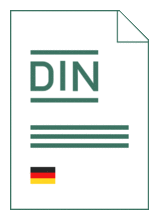
Standard [CURRENT]
DIN 38405-13:2011-04
German standard methods for the examination of water, waste water and sludge - Anions (group D) - Part 13: Determination of cyanides (D 13)
- German title
- Deutsche Einheitsverfahren zur Wasser-, Abwasser- und Schlammuntersuchung - Anionen (Gruppe D) - Teil 13: Bestimmung von Cyaniden (D 13)
- Publication date
- 2011-04
- Original language
- German
- Pages
- 22
- Publication date
- 2011-04
- Original language
- German
- Pages
- 22
- DOI
- https://dx.doi.org/10.31030/1751746
Product information on this site:
Quick delivery via download or delivery service
All transactions are encrypted
Water may contain dissolved and/or undissolved cyanides. They can be present as hydrogen cyanide, cyanide ions, cyanide complexes, organic compounds containing cyano groups and cyanogen chloride. After separation as total cyanide or readily liberated cyanide, the cyanide concentration is determined by photometry. The conventional methods specified in this standard are based on the following definitions: Total cyanide Sum of simple and complex cyanides and cyano groups in inorganic and organic compounds that release hydrogen cyanide under the conditions of this method, for example, cyanohydrins, prussiates. Prussiates are pentacyanoferrates with a further ligand. The concept "total cyanide" is not understood to include simple nitriles, such as acetonitrile and benzonitrile, as well as cyanate ions, thiocyanate ions and cyanogen chloride, nor are these detected by the method described. The CN groups of the compounds defined as "total cyanide" can fully or partially react in water to form cyanide ions or hydrogen cyanide. Readily liberated cyanide Hydrogen cyanide and all compounds that contain cyano groups and release hydrogen cyanide at ambient temperature and a pH value of 4. This includes the simple cyanides of the alkali metals and alkaline earth metals, amongst others. Prussiates and cyanide complexes of cobalt are only partially detected. (When these substances are present, even smaller deviations of the process conditions can cause decisive changes with regard to the measurement values.). Hexacyanoferrate(II), and the nitriles, cyanates, thiocyanates and chlorocyan which have already been excluded are not included. The method according to clause 4 covers the determination of total cyanide and the method according to clause 5 the determination of readily liberated cyanide. The method for determination of total cyanide is validated for waste water with a mass concentration of more than 0,26 mg/l. The method for determination of readily liberated cyanide is validated for waste water with a mass concentration of more than 0,09 mg/l. The applicability of the methods is possible for other types of water whose mass concentration of cyanide compound (calculated as cyanide ions) is higher than 0,01 mg/l, it shall be checked for each case, however. If the mass concentrations of cyanides are higher than 10 mg/l, the sample is diluted or a smaller volume is used. The following modifications have been made with respect to DIN 38405-13:1981-02 and DIN 38405-14:1988-12: a) the method has been completely revised: in particular, the addition of cadmium salts for stabilization of the samples has been deleted and the use of pyridine during photometric determination has been deleted; b) potentiometric methods of determination are no longer covered by the standard, DIN 38405-7 can be used as an alternative; c) the expulsion step has been optimized and the photometric determination has been adjusted according to the new chemism; d) the method has been revalidated for waste water and new results of interlaboratory testing have been determined; d) method DIN 38405-D 13-1 replaces the previous method DIN 38405-D 13-1 and method DIN 38405-D 13-2 replaces the previous method DIN 38405-D 13-2; f) method DIN 38405-D 13-3 Determination of cyanogen chloride has been deleted; g) the standard has been editorially revised; h) this method replaces DIN 38405-14:1998-12; i) the amendments with respect to DIN 38405-14 are to be considered analogously to those of DIN 30405-13. There is no difference to the preservation specifications for the various types of water. This document has been prepared by NA 119-01-03-01-13 AK "Cyanid" ("Cyanides") of NA 119-01-03 AA "Wasseruntersuchung" ("Water analysis") of NAW and been funded by the Länderfinanzierungsprogramm "Wasser, Boden und Abfall" (federal funding programme "Water, soil and waste").
This document replaces DIN 38405-13:1981-02 , DIN 38405-14:1988-12 .
